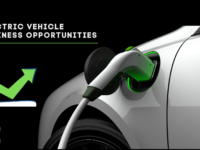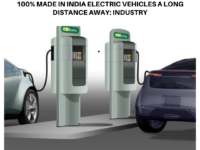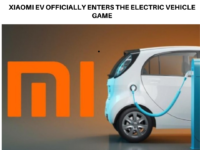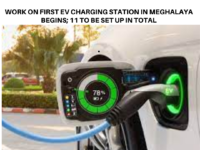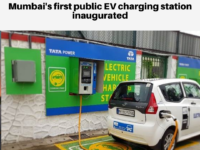If you’re reading this on your smartphone, you’re holding a bomb. Beneath a protective screen, lithium – a metal so volatile that it can ignite on contact with water – is being taken apart and reassembled in the intense chemical reaction that powers much of the modern world.
Lithium is in our phones and tablets, our laptops and smartwatches. It’s in our e-cigarettes and our electric cars. It is light, soft and energy dense, which makes it perfect for portable electronics. But, as consumer technology has grown more powerful, lithium-ion batteries have struggled to keep up. And now, just as the world has been gripped by its addiction to lithium, researchers around the world are scrambling to reinvent the batteries powering our world.
Huge glowing screens, faster processing, speedy data connections and a fashion for thinness mean that some smartphones struggle to make it through a day without being charged. Often more than once. After two years, the battery life of some devices falls off a cliff and they are consigned to the scrapheap.
Silvery lithium’s great strength is also its biggest weakness. It’s unstable. It explodes. A lithium-ion laptop battery holds as much energy as a hand grenade. “Having a smartphone in your pocket is like having kerosene in your pocket,” says Mike Zimmerman, the founder and CEO of Ionic Materials.
Zimmerman has seen the effects first hand at his company’s research lab in Woburn, Massachusetts. In one experiment, a machine drives a nail through a battery pack, which quickly balloons like a bag of microwave popcorn before igniting with a bright flash. The last five decades of battery research have been a tightrope walk between performance and safety – an effort to squeeze as much out of lithium as possible, without pushing it over the edge.
So for now we make do. The global market for power banks – the bulky bricks and cases that people turn to for extra juice – is predicted to reach $25 billion by 2022. But battery life is named by consumers as the single most important feature of a smartphone in poll after poll. As power-hungry 5G rolls out over the next decade, the problem will only get worse. There are huge rewards on offer for those who can solve it.
Ionic Materials is just one of dozens of companies engaged in the epic race to radically rethink the battery. It’s been plagued by false starts, bitter lawsuits, and failed startups. But after a decade of slow progress, there is hope. Scientists at startups, universities and heavily-funded national labs around the world are using sophisticated tools to hunt for new materials. They are seemingly on the verge of vastly improving the energy density and longevity of smartphone batteries, and creating greener, safer devices that will charge in seconds and last all day. It has been an explosive journey.
Batteries generate electricity by splitting chemicals. Every battery built since 1799, when they were invented by Italian physicist Alessandro Volta to settle an argument about frogs, has had the same key components: two metal electrodes – the negatively charged anode and the positively charged cathode, separated by a substance called the electrolyte.
When a battery is connected to a circuit, metal atoms in the anode undergo a chemical reaction. They lose an electron, becoming negatively charged ions, and are drawn through the electrolyte towards the positive cathode. At the same time, the electron – also negatively charged – flows to the cathode as well. But instead of going through the electrolyte, it travels around the outside of the battery via the circuit, powering whatever device it is connected to.
The metal at the anode eventually runs out of atoms to give up, and the battery runs out of juice. But in a rechargeable cell, the process can be reversed by applying an electric current, which forces ions and electrons back to the anode ready to be used again.
Electrodes made of pure metal can’t withstand the constant push and pull of atoms in and out without collapsing, so rechargeable cells have to use combinations of materials that allow the anode and cathode to hold their shape through repeated charging cycles. These can be loosely compared to apartment buildings, with ‘rooms’ for the reactive elements. The performance of a rechargeable battery is largely set by how quickly, and how fully, you can move ions in and out of these rooms without the building collapsing.
In 1977, Stan Whittingham, a young British scientist working at an Exxon plant in Linden, New Jersey, built an anode that used aluminium to form the walls and floors of the apartment block, and lithium as the active material. When he charged his battery, lithium ions moved from the cathode to the anode, settling into empty spaces between the aluminium atoms. When discharged, they moved the other way, back through the electrolyte to spaces on the cathode side.
He had created the world’s first rechargeable lithium battery – a coin-sized cell that worked well enough to power a solar watch. But when he tried to increase the voltage – to move more ions in and out – or attempted to make bigger cells, they kept igniting. Eventually, the local fire department threatened to start charging for visits.
Then, in 1980 John Goodenough, an American physicist working at Oxford University, made a breakthrough. Goodenough, an evangelical Christian who had served in the Second World War as a US Army meteorologist, was an expert in metal oxides and he suspected that they might provide a more robust cage for lithium than the aluminium compound that Whittingham had used.
He instructed two postdoctoral researchers to systematically work their way through the periodic table, testing pairings of lithium with different metal oxides to see how much lithium could be pulled out of them before they collapsed. Eventually, they settled on a combination of lithium and cobalt, a bluish grey metal found across central Africa.
Lithium-cobalt-oxide could withstand as much as half of its lithium being pulled out. When used as a cathode, it represented a huge step forwards – a light, inexpensive material suitable for both small and large devices, and vastly superior to anything else on the market.
Today, Goodenough’s cathode is in virtually every handheld device on the planet, but he didn’t make a penny from it. Oxford University declined to patent it, and he signed away the rights. But it changed what was possible.
In 1991, after a decade of tinkering, Sony combined Goodenough’s lithium-cobalt-oxide cathode with a carbon anode to try and improve the battery life of its new CCD-TR1 camcorder. It was the first rechargeable lithium-ion battery in a consumer product, and it changed the world.

An aerial view of electric cars fresh from the production line at Kandi’s factory in Jinhua, Zhejiang province, China
Gene Berdichevsky was employee number seven at Tesla. When the electric car company was founded in 2003, there had been a decade of steady improvement in the energy density of batteries – about seven per cent per year. But by the mid-2000s, he noticed performance starting to plateau. Over the last seven or eight years, scientists have had to fight “tooth and nail” for gains of even half a percent.
The advances in that time have largely come from engineering and manufacturing improvements. “Over the 27 years that today’s chemistries have been used they have been really just been refined,” says Berdichevsky. Materials are purer, and battery makers have been able to pack more active material into the same space by making each layer thinner. Berdichevsky calls it “taking air out of the can”.
But that comes with its own risks. Modern batteries consist of ultra-thin alternating layers of cathode, electrolyte and anode materials sandwiched tightly together with copper and aluminium charge collectors to carry the electrons out of the cell to where they’re needed.
In some high-end batteries, the plastic separator which sits between the cathode and anode to prevent them from touching and short-circuiting can be as thin as six microns – about one tenth the thickness of a human hair – which leaves them very susceptible to crush damage.
It’s why airline safety videos will now tell you not to adjust your seat if your phone falls into the mechanism.
For every improvement to lithium-ion, there’s a trade-off. Improving the energy density can compromise safety. Introducing fast-charging can reduce the cycle life, meaning that the battery degrades more quickly. Lithium-ion is approaching its theoretical limits.
Ever since Goodenough’s breakthrough, researchers have been trying to find the next leap forwards, by systematically interrogating the four major components of batteries – cathode, anode, electrolyte and separator – with ever more sophisticated tools.
Clare Grey, who was a student of Goodenough’s at Oxford, has been one of many working on lithium-air, where oxygen in the air acts as the other electrode. Theoretically, these cells offer a huge increase in energy density, but getting them to recharge reliably and last longer than a few dozen cycles has been difficult enough in the lab, let alone in the dirty and unpredictable air of the real world.
Although Grey claimed a recent (and much disputed) breakthrough, because of these problems, the attention of the research community has largely turned to lithium-sulfur. It offers a cheaper, more powerful alternative to lithium-ion, but scientists have struggled to stop the dendrites forming at the cathode, and sulfur at the anode from dissolving with repeated charging. Sony claims to have solved the problem, and is hoping to ship consumer devices with lithium-sulfur batteries by 2020.
At the University of Manchester, materials scientist Xuqing Liu is among those trying to squeeze more life out of the carbon anode, by incorporating 2D materials similar to graphene that can grow the surface area, and therefore boost the number of lithium atoms it can hold. He likens it to increasing the number of pages in a book. The university is also investing in a dry room which will allow it to safely and easily swap different components to test different combinations of electrodes and electrolytes.
Incredibly, even Goodenough himself is still working on the problem. Last year, at the age of 94, he published a paper describing a battery with three times the capacity of existing lithium-ion cells. It was widely discredited. “If anyone but Goodenough published this, I would be, well, it’s hard to find a polite word,” says one researcher.
But despite thousands of published papers, billions of dollars spent and dozens of startups formed and funded, the basic chemistry powering most of our consumer electronics has barely changed since 1991. Nothing has been able to replace the combination lithium-cobalt-oxide and carbon (now used in the form of graphite) on cost, performance and portability for consumer electronics. The iPhone X has almost exactly the same materials in its battery as that first Sony camcorder.
And so, after, shepherding the power cells for the Tesla Roadster from the drawing board to the production line, Berdichevsky left the company in 2008 to investigate new battery chemistries. He was particularly interested in finding alternatives to the graphite anode, which he saw as the biggest roadblock to better batteries. “Graphite has been at the limits for six or seven years now,” he says. “It’s basically used at its thermodynamic capacity in batteries today.”
In 2011, he co-founded Sila Nanotechnologies with Alex Jacobs, a former Tesla colleague, and Gleb Yushin, a materials professor at Georgia Institute of Technology. Their Bay Area office in Alameda has an open-plan layout, conference rooms named after Atari games, and an industrial laboratory full of furnaces and gas lines.
After surveying all the potential solutions to the problem, the trio settled on silicon as the most promising material from a theoretical standpoint. They just needed to make the technology work. Many had tried before them and failed. Berdichevsky and his colleagues were optimistic they could succeed.
An atom of silicon can attach to four lithium ions, which means that compared to a graphite anode of similar weight, a silicon one can store ten times as much lithium. That potential has meant a long history of interest in silicon anodes from national research institutes, and lavishly venture capital-funded startups such as Amprius, Enovix, and Envia – which had a high-profile falling out with General Motors after it failed to deliver on production promises.
When lithium ions attach to the anode as a battery is charged, it swells up slightly, and then shrinks again as it’s used. Over repeated charging cycles, this swelling and shrinking damages the solid-electrolyte-interface layer, a protective substance that forms on the surface of the anode like plaque. That damage creates side reactions, which consume some of the lithium in the battery. “It gets trapped into useless junk,” says Berdichevsky.
This is the main reason why smartphones start to lose their capacity over time. A graphite anode swells and shrinks by about seven per cent, so it can manage about a thousand full charging cycles before performance starts to slide dramatically. That equates to about two years of daily charges for a smartphone. But because silicon particles hold so much lithium, they swell much more dramatically – by up to 400 per cent – when charged. Most silicon anodes tear themselves apart after a handful of charging cycles.
Over five years in the laboratory, Sila created a nano-composite material to tackle the swelling problem.
If a graphite anode is an apartment block, it’s one where all the rooms are the same size, and packed closely together, explains Berdichevsky. Over 30,000 iterations – different combinations of pillars and rooms – they’ve built an anode where every floor has empty space for the silicon atoms to expand into as they pick up lithium. “We trap this extra space inside the structure,” he says. This accounts for the swell, while keeping the external size and shape of the anode stable.
Berdichevsky says the first version of Sila Nanotechnologies’ material, which will be available to manufacturers next year, could improve energy density by 20 per cent, and that eventually it could create a 40 per cent boost, while also improving safety. “Silicon enables you to back away from the edge,” he says. “You can take one or two per cent back out in favour of increasing your safety margin really significantly.”
Crucially, it can also be swapped straight into existing designs. With battery producers in Asia scrambling to increase factory capacity to prepare for the age of electric cars, Berdichevsky believes that anything not compatible with current manufacturing processes could be locked out. “If the technology doesn’t exist today that would replace lithium-ion, by the time it comes to market it will be facing an installed base of tens of millions.”

A man works on the salt flats in Uyuni, Bolivia. The remote, 4,000 square mile expanse contains the world’s largest reserve of lithium
As lithium ions dance between the two electrodes when a battery is charged and discharged, they sometimes struggle to make it all the way home. Instead, particularly when the battery is charged too quickly, they can accumulate on the outside of the electrode, growing into branching dendrites that form over time like stalactites on the roof of a cave. Eventually, these dendrites – which look like frost on a window pane – can actually reach all the way through the electrolyte, pierce through the separator, and create a short-circuit by touching the electrode on the opposite side.
As the layers get closer together, this risk increases, and there is less margin for error. Getting it wrong can be damaging and expensive, as Samsung discovered last year. A tiny manufacturing defect caused a short-circuit inside the batteries of Galaxy Note 7 tablets. In some devices, the anode and the cathode ended up in contact with each other – a disaster that cost Samsung an estimated £3.4bn in recall costs. When that happens, “the cell gets very hot,” explains Zimmerman of Ionic Materials. “When it gets hot, the liquid electrolyte goes into thermal runaway and eventually catches fire and explodes.”
Because it’s so dangerous, there’s not actually that much lithium in lithium-ion batteries – only about two per cent. But if there were a way to safely incorporate pure metallic lithium, like Stan Whittingham tried to do in the 1970s, and to free the metal from its cobalt-oxide cage, it could potentially unlock a tenfold increase in energy density. This has been called ‘the holy grail’ of battery research, and Zimmerman might have found it.
He believes that the electrolyte is actually the biggest impediment to increasing the energy density of batteries. There has been a gradual move away from using substances soaked in liquid electrolyte towards gels and polymers, but they’re generally still flammable, and do nothing to stop the speeding train of thermal runaway.
By his own admission, Zimmerman is not “a battery person”. His background is in materials science, specifically polymers, and he spent 14 years at Bell Labs and teaching at Tufts University before striking out on his own as an entrepreneur.
In the early 2000s, he became interested in rechargeable batteries. At the time, there had been some efforts to move away from liquid electrolytes towards solid-state electrolytes. “In principle, because they’re safer, you can make it work harder,” explains veteran energy storage scientist Donald Highgate. “You can have a smaller cell for the same application.” But they have mostly been ceramic or glass-based and therefore brittle and difficult to manufacture at scale.
Plastic was already being used in batteries for the separator – sitting in the middle of the electrolyte to stop the electrodes from touching. Zimmerman reasoned that, if he could find the right material, he could ditch the liquid and the separator and replace them with one solid layer of plastic, which would be flame-resistant, and have the added benefit of stopping dendrites from growing between the layers.
With Ionic Materials, Zimmerman created a polymer with an entirely new conduction mechanism, modelled on the way electrons move through metals. It’s the first solid-state polymer that can conduct lithium-ions at room temperature. The material is flexible, low-cost, and stands up to all manner of abuse. Ionic Materials drove screwdrivers through their battery packs, shot them with bullets, and lop pieces off them with scissors without them heating up or halting the flow of electrons.
For one experiment, they sent a prototype to a ballistics facility normally used to test bulletproof vests and peppered it with 9mm ammunition. Two wires connected the cell, a flat silver pouch, to a Samsung tablet whose own power source had been very carefully removed. When the bullets hit, the battery burst like a volcano. In a slow motion video, plastic and metal spurt out of the craters like lava. But there was no eruption, no explosion or fire inside the battery pack. With each impact – one, two, three – the device stayed switched on. “We always thought the polymer would make it safe,” says Zimmerman. “We never counted on the battery still working afterwards.”
According to Zimmerman, the polymer will enable a move towards lithium metal and accelerate the adoption of new battery chemistries such as lithium-sulfur or lithium-air. But the long-term future could lie beyond lithium. “The improvement cannot match the development of the performance of the device,” says Liu, the researcher at Manchester University who is chipping away with a chisel at a problem that might require a sledgehammer. “We need a revolution.”
At the sprawling Harwell Science and Innovation Campus in Oxfordshire, where John Goodenough signed away the rights to his big lithium-ion breakthrough, Stephen Voller holds aloft a piece of carbon fibre about the same size and shape as a drinks coaster.
Voller, a genial Manchester City fan in his late 50s, worked for IBM as a software engineer before joining Netscape, one of the first big internet brands. During a year on gardening leave after the company was acquired by AOL, he grew increasingly frustrated with the limitations of his laptop’s battery life, and decided to do something about it.
His first idea was to use hydrogen fuel cells to extend battery life, but its volatility proved an insurmountable challenge for portable electronics. “It’s quite difficult to take hydrogen through airport security,” he says. Then, through acquaintances at Oxford University, he heard about some exciting work on an extremely fast-charging material that behaves more like a supercapacitor. While a battery stores energy chemically, supercapacitors hold it in an electrical field, like static collecting on a balloon.
The problem with supercapacitors is that they can’t store as much energy as batteries, and it leaks out very quickly. Where lithium-ion will hold its charge for as long as two weeks if you don’t use it very much (remember your old Nokia?), a supercapacitor can run flat in a few hours.
Some in the industry believe that combining supercapacitors with batteries could be a boon for smartphones and other power-hungry consumer tech devices. Instead of trying to build a phone that lasts all day, Donald Highgate says supercapacitors could be used to create hybrid phones that charge up in a minute or two, and also have a lithium-ion cell on board as a backup. “If you had a very rapid recharge, you could put it down on an induction loop and it would charge while you were stirring your coffee,” he says.
Voller thinks he can go one better. In 2013, he founded ZapGo, which is developing carbon-based batteries that charge as quickly as supercapacitors, but hold their charge for as long as lithium-ion. By November 2017, it had grown to 22 staff, split across offices at the Rutherford Appleton Laboratory at Harwell, and in Charlotte, North Carolina. Its first consumer cells will be rolling out in third-party products towards the end of this year, including a jump-start kit for cars, and an electric scooter where the charge time is reduced from eight hours to five minutes.
The piece of carbon fibre he holds in his hand is a battery, with a solid-state electrolyte that can’t catch on fire, and two electrodes made of thin layers of aluminium that have been coated with nano-structured carbon, designed to increase the surface area. “You want it to look like the Himalayas,” says Voller, although under a microscope it’s more like the silhouette of a city skyline. The key to ZapGo’s technology has been to increase the efficiency and reduce the amount of leakage by making sure that the electrolyte fits seamlessly into that carbon skyline from above, like Velcro.
The biggest advantage is longevity. Because ZapGo’s cell stores charge more like a balloon than a traditional battery – as Voller says, “there’s no chemistry going on” – he claims it can last for 100,000 discharge cycles. That’s 100 times better than lithium-ion. It’s 30 years of charging your phone every day.
The current, third generation of ZapGo cells aren’t yet powerful enough to run a smartphone, but because the materials used offer no barrier to increasing the voltage, Voller expects to get there by 2022, or “around the iPhone 15”.
It would require a change in charging infrastructure. The fat bit of your smartphone charger is designed to slow down the amount of electricity flowing into the battery from the grid, to arrest degradation and stop it from catching on fire. Some explosive incidents have been blamed on cheap third-party chargers which don’t have the electronics required to do that.
For ZapGo’s battery, or any supercapacitor-based system, you would need a charger that could do the opposite – store up energy from the wall, and then deliver it to your phone in one short, sharp blast. In the lab, Voller’s team have built something about the size of a laptop power supply, but they’re working to make it smaller and more efficient.
Some, including Sam Cooper of the Dyson School of Design Engineering, have questioned whether companies would actually want to put a device that lasts that long into their products. “There is a clear profit incentive for phone companies to have the device die in time for the next release.This race may not exist,” he says, bluntly. Voller admits that among the 30 or so patents that ZapGo holds is a way to artificially degrade the life of its cells, to stop them from lasting for three decades. “We wouldn’t do that, but we have the ability to offer it to our customers if they choose to do it,” he says.
Carbon-based energy storage has another major advantage over existing technologies. It can actually be used as part of the external structure of the phone. Instead of designing batteries to fit into current phone designs, Voller is preparing for a future of flexible screens and foldable devices, where all our data is pulled from the cloud over 5G, and battery life becomes even more important.
Walking down the narrow corridor of his office and out into the afternoon sun, Voller passes through the shadow of Diamond Light Source, a huge ring-shaped building that looks like an alien spaceship has landed in the Oxfordshire countryside. Inside, researchers are using intense beams of accelerated light to interrogate potential battery materials at the microscopic scale – probing why lithium-sulfur is failing, and searching for alternative materials for anodes and cathodes – still chiselling away at the same problem that has occupied the field for almost thirty years.
Voller waves his smartphone in the air, bemoaning the shortcomings of lithium-ion that have driven him, and hundreds of others, to join the high-stakes race to reinvent the brilliant but flawed battery. “We’ve all had to evolve strategies to deal with it, whether it’s clip on batteries, or carrying two phones,” he says. “It’s crazy. It shouldn’t be like that.”
This article is part of our WIRED on Energy series.
Join our list
Subscribe to our mailing list and get interesting stuff and updates to your email inbox.



